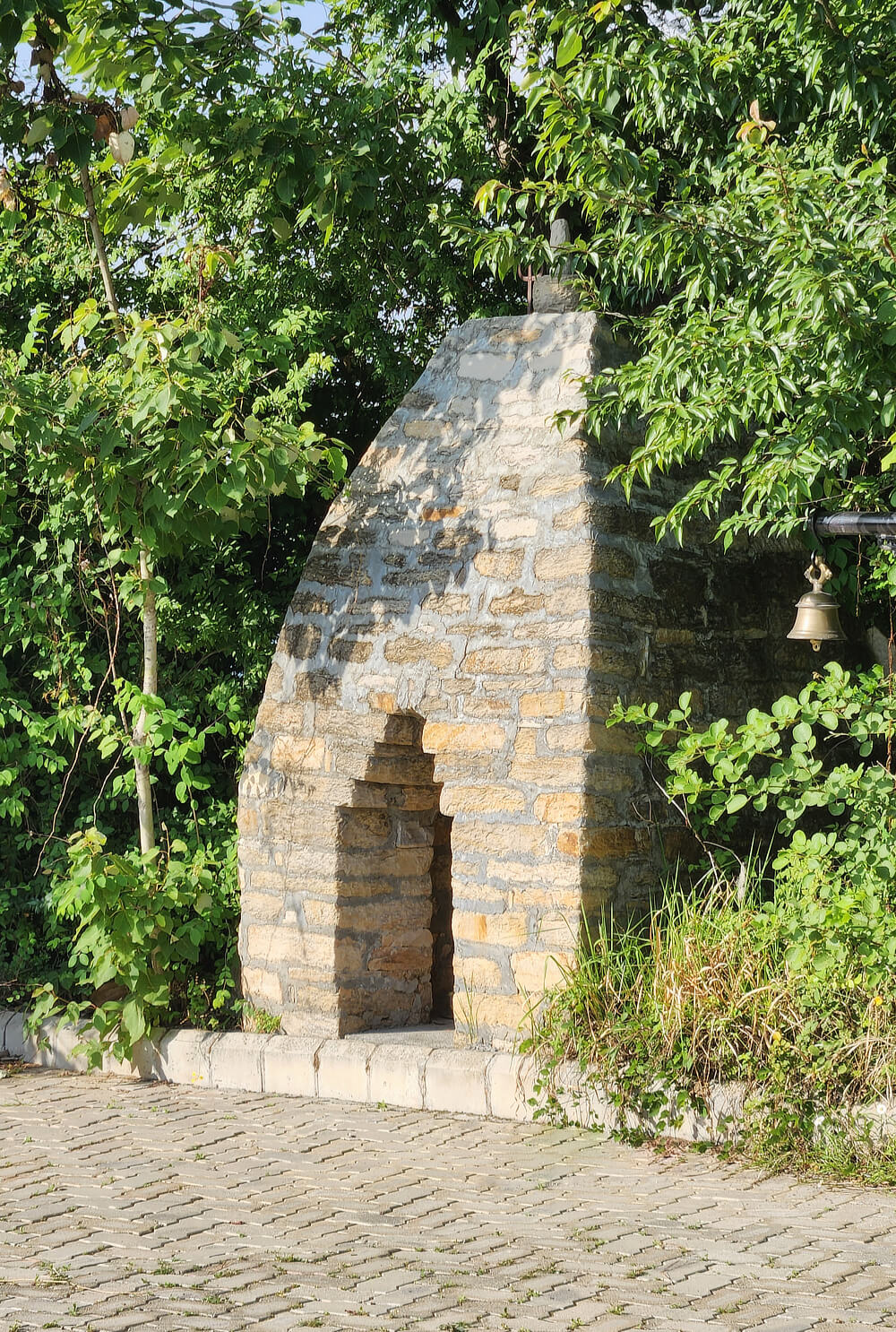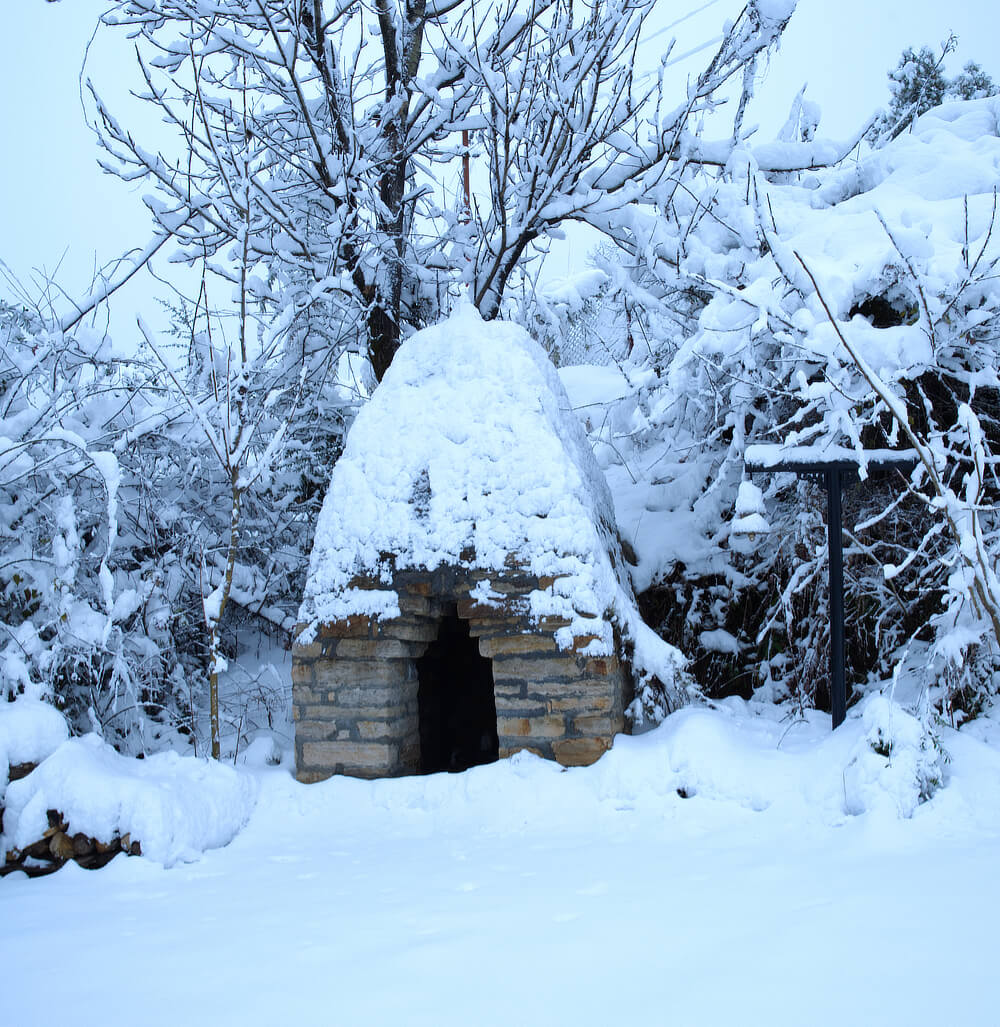
In the past, our orchard, along with several other adjacent orchards, constituted a single expansive piece of land. During the process of tilling the soil, two distinctive ‘Lingas’ (representing or serving as icons of Lord Shiva) were unearthed in this region a long time ago. In response, a temple was established beneath an ancient oak tree nearby. However, with time, the temple gradually fell into neglect, and eventually, a house began to be constructed at that very site. The village elders felt a deep sense of sadness, although they refrained from openly expressing their concerns. Subsequently, it was collectively decided to relocate the temple to a new site. Several years ago, the bhoomi devtas were reverently shifted to their new abode.
Fascinatingly, when the moment arrived to shift the two stones to their new location, heavy snowfall unexpectedly commenced on that very day. However, as an auspicious time had already been determined, the people unanimously agreed to proceed with the planned relocation. Following proper ceremonies, a diya (oil lamp) was kindled, illuminating the surroundings, and the Bhoomi Devtas (the sacred stones) were gently lifted from their previous abode. Miraculously, as this transference took place, the rain and snow ceased abruptly, akin to a tap being turned off. Only the wind continued to blow. The small procession then reverently carried the Bhoomi Devtas to their new destination. The flame on the diya continued to flicker, never once diminishing. Once the translocation was successfully completed and the customary prayers were offered, the snow resumed, as if signifying a divine endorsement of the move from the old site to the new temple. The priest and the villagers rejoiced, grateful that the Bhoomi Devtas had seemingly consented to the relocation, and the flame of the diya persisted, unwaveringly illuminating their path.
During the construction of the new temple, a remarkable discovery unfolded as a third stone emerged from the ground at the designated site. Many consider it to be a representation of the revered holy trinity. Thus, the temple now proudly houses the three stones symbolizing the Bhoomi Devtas. In addition, a shivlinga was later installed within the same sacred space.

Legend of Bhoomi Devta (Bhumiya Devta / भूमिया देवता )
In the early stages of settlement in these lands, as villagers began cultivating the soil, they occasionally unearthed peculiar stones that appeared to be cut and shaped, distinct from the surrounding soil and the common stones typically found in the region. These unique stones were referred to as Bhoomi Devtas and were worshipped as ‘Lingas’ or ‘ShivLingas’.
Another legend has it that a drummer (हुड़का बजाने वाला), seeking alms, arrived at the house of a wealthy landlord. Unfortunately, only a blind old lady was present at the time. Unaware of her mistake, she inadvertently served the drummer a bowl of spicy soup. Upon reaching the king’s palace, the drummer expressed dissatisfaction with the meager alms offered by the king. In a fit of frustration, he mentioned the unpleasant treatment he had received at the landlord’s house. This comment provoked the king, who, seeking to assuage the drummer’s anger, mobilized his soldiers and devised a plan to punish the landlord. Fearing the king’s retribution, the landlord, in desperation, locked himself and his entire family, including their dog and cat, inside their house. Tragically, they resorted to the extreme act of setting the house ablaze, perishing in the flames. It is said that Lord Shiva, witnessing this grave injustice, bestowed a divine boon upon the ill-fated landlord. From that moment on, he and his family were forever known as Bhoomi Devtas, and they would be remembered when prayers were offered to Lord Shiva himself.
Bhoomi Devta(s) holds significant importance in almost every village, is revered as the guardian of the land, and is often referred to as Kshetrapal. Prior to the commencement of sowing, hill farmers ritualistically scatter seeds in the temple of Bhoomi Devta(s). Besides various festivals, the worship of Bhoomi Devtas continues even after the successful harvest of Rabi and Kharif crops. As the crops mature, the initial yield is offered as an offering to the deity, and the dishes prepared from the crops are also presented to Bhoomi Devtas. In fruit orchards, offerings are made from the first harvest of fruits. They are worshipped in the form of a natural linga (usually more than one stone).
While Bhoomi Devtas are commonly associated with Lord Shiva, it is worth noting that the concept of Bhoomi Devi (in female form) is sometimes linked to the consort of Lord Vishnu’s Varaha Avatar, or even to Maa Barahi. As time has passed, the true origins of the Bhoomi Devtas have become obscured, and they are now regarded as regional deities. The focus of the worshipers is not on delving into the historical roots, but rather on continuing the worship traditions established by their ancestors, generation after generation. It is a reverence passed down through the ages, honouring the deity as their predecessors and their predecessors’ predecessors once did. However, as time has passed, the significance of these local deities has gradually waned, resulting in a decline in the frequency of prayers offered to them. Today, they are rarely worshipped or invoked in the villages in this form. In modern times, it has become a common practice for the priests to collectively offer prayers to all the regional deities (ग्रामदेवताभ्यो नमः), rather than individually invoking each deity.
You are free to offer your prayers and meditate in front of the temple. There are no restrictions of any kind. We just request you to please be respectful of our religion and culture. Please uphold the sanctity of the place.
